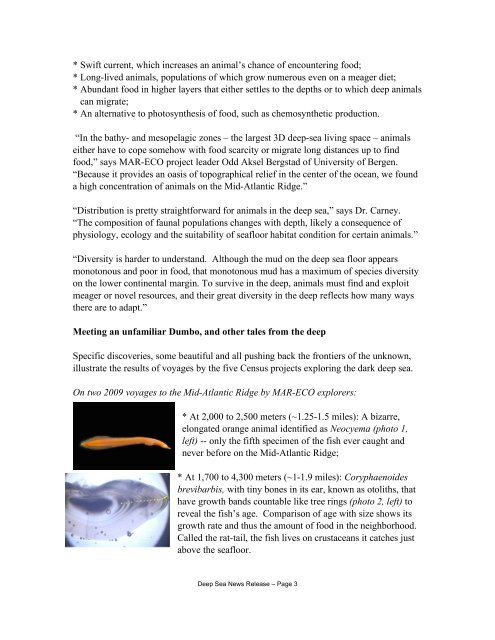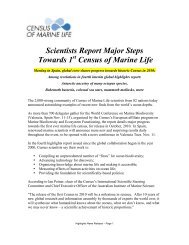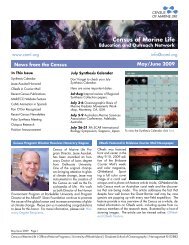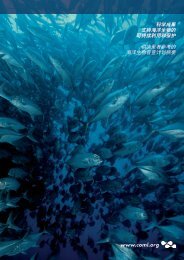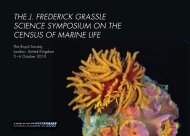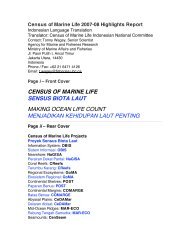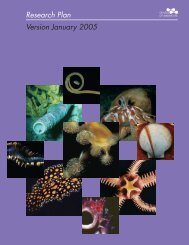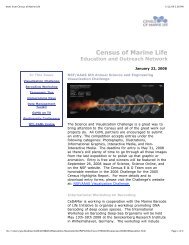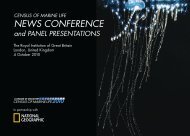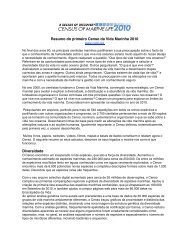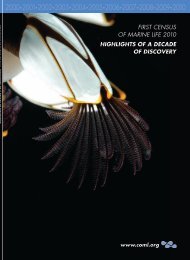From the Edge of Darkness to the Black Abyss - Census of Marine Life
From the Edge of Darkness to the Black Abyss - Census of Marine Life
From the Edge of Darkness to the Black Abyss - Census of Marine Life
Create successful ePaper yourself
Turn your PDF publications into a flip-book with our unique Google optimized e-Paper software.
* Swift current, which increases an animal’s chance <strong>of</strong> encountering food;* Long-lived animals, populations <strong>of</strong> which grow numerous even on a meager diet;* Abundant food in higher layers that ei<strong>the</strong>r settles <strong>to</strong> <strong>the</strong> depths or <strong>to</strong> which deep animalscan migrate;* An alternative <strong>to</strong> pho<strong>to</strong>syn<strong>the</strong>sis <strong>of</strong> food, such as chemosyn<strong>the</strong>tic production.“In <strong>the</strong> bathy- and mesopelagic zones – <strong>the</strong> largest 3D deep-sea living space – animalsei<strong>the</strong>r have <strong>to</strong> cope somehow with food scarcity or migrate long distances up <strong>to</strong> findfood,” says MAR-ECO project leader Odd Aksel Bergstad <strong>of</strong> University <strong>of</strong> Bergen.“Because it provides an oasis <strong>of</strong> <strong>to</strong>pographical relief in <strong>the</strong> center <strong>of</strong> <strong>the</strong> ocean, we founda high concentration <strong>of</strong> animals on <strong>the</strong> Mid-Atlantic Ridge.”“Distribution is pretty straightforward for animals in <strong>the</strong> deep sea,” says Dr. Carney.“The composition <strong>of</strong> faunal populations changes with depth, likely a consequence <strong>of</strong>physiology, ecology and <strong>the</strong> suitability <strong>of</strong> seafloor habitat condition for certain animals.”“Diversity is harder <strong>to</strong> understand. Although <strong>the</strong> mud on <strong>the</strong> deep sea floor appearsmono<strong>to</strong>nous and poor in food, that mono<strong>to</strong>nous mud has a maximum <strong>of</strong> species diversityon <strong>the</strong> lower continental margin. To survive in <strong>the</strong> deep, animals must find and exploitmeager or novel resources, and <strong>the</strong>ir great diversity in <strong>the</strong> deep reflects how many ways<strong>the</strong>re are <strong>to</strong> adapt.”Meeting an unfamiliar Dumbo, and o<strong>the</strong>r tales from <strong>the</strong> deepSpecific discoveries, some beautiful and all pushing back <strong>the</strong> frontiers <strong>of</strong> <strong>the</strong> unknown,illustrate <strong>the</strong> results <strong>of</strong> voyages by <strong>the</strong> five <strong>Census</strong> projects exploring <strong>the</strong> dark deep sea.On two 2009 voyages <strong>to</strong> <strong>the</strong> Mid-Atlantic Ridge by MAR-ECO explorers:* At 2,000 <strong>to</strong> 2,500 meters (~1.25-1.5 miles): A bizarre,elongated orange animal identified as Neocyema (pho<strong>to</strong> 1,left) -- only <strong>the</strong> fifth specimen <strong>of</strong> <strong>the</strong> fish ever caught andnever before on <strong>the</strong> Mid-Atlantic Ridge;* At 1,700 <strong>to</strong> 4,300 meters (~1-1.9 miles): Coryphaenoidesbrevibarbis, with tiny bones in its ear, known as o<strong>to</strong>liths, thathave growth bands countable like tree rings (pho<strong>to</strong> 2, left) <strong>to</strong>reveal <strong>the</strong> fish’s age. Comparison <strong>of</strong> age with size shows itsgrowth rate and thus <strong>the</strong> amount <strong>of</strong> food in <strong>the</strong> neighborhood.Called <strong>the</strong> rat-tail, <strong>the</strong> fish lives on crustaceans it catches justabove <strong>the</strong> seafloor.Deep Sea News Release – Page 3


